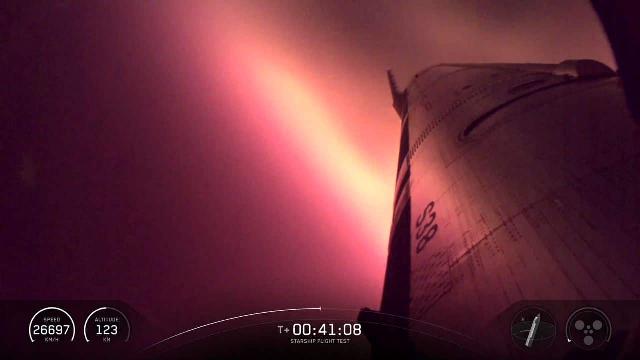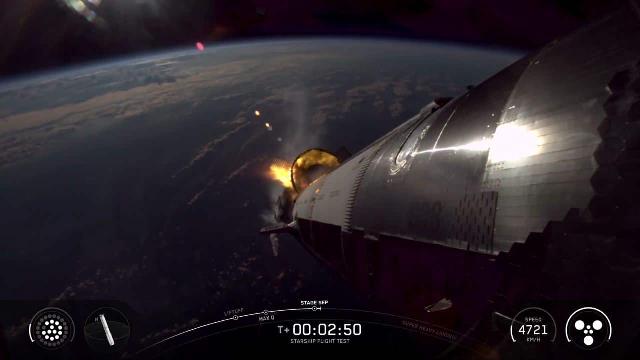This happened despite the fact that the company deliberately weakened the ship's thermal protection, including in the most critical places. For the first time, the standard payload launch system worked properly: eight mock-ups of satellites with a total weight of 16 tons were delivered there. The tests were the last flight of Starship V2. Starting from the next flight, Starship V3 will go into space.
Today, on October 14, 2025, at 2:23 a.m. Moscow time, the eleventh test launch of the two-stage Starship system took place from the SpaceX spaceport in Texas. For the first time ever, the test flight of both stages took place without a single lining, which could become critical in real flight.
This could significantly increase the chances of the United States succeeding in the moon race with China if not for the fact that this is the last flight of the second version of Starship. The third version will contain so many technical innovations that the first flights may not demonstrate the same degree of reliability.
The first stage of the Starship, B15-2, performed almost flawlessly. She had previously flown into space and was put on the launch tower. B15-2 became the second reused first stage of the Starship. Saving and reusing the first stage is technically much easier than the second, since the speed of the latter is much higher, which makes it much more difficult to extinguish it.
In the new launch, she tested a new braking mode, the 13-5-3 circuit. In this case, the first stage, after separation from the second, first restarts 13 Raptor engines out of 13 for the first braking phase. Then there are five workers, after which there are only three. Prior to this, the 13-3 mode was used, when only three engines continued to operate immediately after the first braking maneuver. 13-5-3 will make the braking of the first stage smoother.
The ultimate goal of the new rocket and spacecraft is multiple space flights, including with people on board. That's why SpaceX is also testing partial heat shield modes made of ceramic tiles to avoid shuttle—style emergencies and disasters. Today, the company launched a ship with more than a hundred intentionally removed heat shield tiles, in groups of four at each removal point. Previously, the removed tiles were placed one at a time, creating a smaller heating spot when braking in the atmosphere.
Only one tile was removed at one point: on the bow of the ship (which is also the second stage of the rocket). This is potentially dangerous, since the nose not only gets very hot when entering the atmosphere, but also covers a small oxygen tank that ensures landing. If the cladding had burned out, an explosion would have occurred at this point, which never happened.

A serious thermal load did not lead to a single burnout of the Starship skin, even despite the deliberate weakening of thermal protection. The choice of stainless steel as a material probably had an effect. Aluminum alloys, from which rockets were made earlier, are far from being so resistant to high temperatures.
Image source: SpaceX
Last year, on its tenth test flight, the company tested launching eight mock-ups of Starlink V3 satellites into space. They are significantly larger than their predecessors, weighing two tons each, and in the last flight, their unloading by a special device was unnecessarily abrupt, with noticeable impacts. This time, the withdrawal system worked smoothly. This is very important because shock loads can damage the satellite's equipment and the ship's airlock.
After removing 16 tons of payload, the second stage tested restarting one of its Raptor engines in orbit. Technically, this is not an easy task: proper ignition of the engine in vacuum is not always successful, even on long-used systems.
Despite the seriously weakened thermal protection, the ship then entered the atmosphere normally, slowed down as planned exactly above a given point in the Indian Ocean and conducted a soft landing simulation. It is called a simulation because the Starship should land on the launch tower, and not on the water, as during these tests. Otherwise, the landing is similar, since it is required to slow down to exactly the set speed.
Before landing, the ship hovered in the air, simulating a rescue. Then the engines were turned off and he fell into the Indian Ocean / © SpaceX's testing success is almost complete: the first stage failed to launch one of the 13 planned Raptor engines, and this is almost the only noticeable anomaly. However, due to the multi-engine nature of the system, this number was quite sufficient for controlled braking, despite the fact that the atmospheric entry angles for both stages were chosen to be the most aggressive (that is, with the highest loads and heating).
Earlier, after several unsuccessful Starship launches in a row, many industry observers in the United States predicted China's victory in the moon race. Naked Science discussed in detail in a separate text why this is unlikely, although it would be the best option for the development of events.

